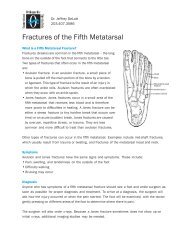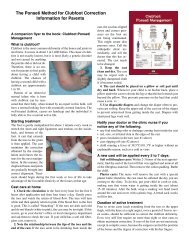Plantar Wart (Verruca Plantaris) - CT-Ortho.com
Plantar Wart (Verruca Plantaris) - CT-Ortho.com
Plantar Wart (Verruca Plantaris) - CT-Ortho.com
Create successful ePaper yourself
Turn your PDF publications into a flip-book with our unique Google optimized e-Paper software.
Dr. Eliza Addis-Thomas<br />
203.407.3515<br />
<strong>Plantar</strong> <strong>Wart</strong> (<strong>Verruca</strong> <strong>Plantar</strong>is)<br />
What is a <strong>Plantar</strong> <strong>Wart</strong>?<br />
A wart is a small growth on the skin that develops<br />
when the skin is infected by a virus. <strong>Wart</strong>s can develop<br />
anywhere on the foot, but typically they appear on the<br />
bottom (plantar side) of the foot. <strong>Plantar</strong> warts most<br />
<strong>com</strong>monly occur in children, adolescents, and the elderly.<br />
There are two types of plantar warts:<br />
• A solitary wart is a single wart. It often increases in<br />
size and may eventually multiply, forming<br />
additional “satellite” warts.<br />
• Mosaic warts are a cluster of several small warts<br />
growing closely together in one area. Mosaic<br />
warts are more difficult to treat than solitary warts.<br />
Causes<br />
<strong>Plantar</strong> warts are caused by direct contact with the human papilloma virus (HPV). This is the same<br />
virus that causes warts on other areas of the body.<br />
Symptoms<br />
The symptoms of a plantar wart may include:<br />
• Thickened skin. Often a plantar wart resembles a callus because of its tough, thick tissue.<br />
• Pain. Walking and standing may be painful. Squeezing the sides of the wart may also cause pain.<br />
• Tiny black dots. These often appear on the surface of the wart. The dots are actually dried<br />
blood contained in the capillaries (tiny blood vessels).<br />
<strong>Plantar</strong> warts grow deep into the skin. Usually this growth occurs slowly, with the wart starting small<br />
and be<strong>com</strong>ing larger over time.<br />
Diagnosis and Treatment<br />
To diagnose a plantar wart, the foot and ankle surgeon will examine the patient’s foot and look for<br />
signs and symptoms of a wart.<br />
Although plantar warts may eventually clear up on their own, most patients desire faster relief. The<br />
goal of treatment is to <strong>com</strong>pletely remove the wart.<br />
The foot and ankle surgeon may use topical or oral treatments, laser therapy, cryotherapy (freezing),<br />
acid treatments, or surgery to remove the wart.
Regardless of the treatment approaches undertaken, it is important that the patient follow the<br />
surgeon’s instructions, including all home care and medication that has been prescribed, as well<br />
as follow-up visits with the surgeon. <strong>Wart</strong>s may return, requiring further treatment.<br />
If there is no response to treatment, further diagnostic evaluation may be necessary. In such<br />
cases, the surgeon can perform a biopsy to rule out other potential causes for the growth.<br />
Although there are many folk remedies for warts, patients should be aware that these remain<br />
unproven and may be dangerous. Patients should never try to remove warts themselves. This<br />
can do more harm than good.
















